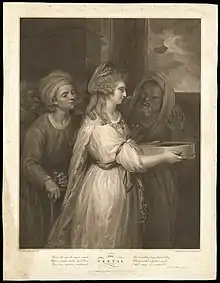
Tuccia (3rd-century BC[1]), was an ancient Roman Vestal Virgin. Its supposed by her cognomen that she belonged to the Gens Tuccia. She is known for an incident in which her chastity was questioned by a spurious accusation. The punishmen for vestal virgins who lost their chastity were if they could not prove their innocence - were to be sentenced to immurment. In Tuccia's case, to save her reputation and life she utilized a flat perforated basket to carry water,from the Tiber to the Temple of Vesta without the water falling to the ground through the sieve.
After showing she was as chaste as she said, her accuser was never heard from again.[2]
Vestal virgins were thought to possess magical powers[3] by their service to Vesta and thus by performing this miracalous action Tuccia had not only proven her chastity but also that she was favored by Vesta.
This very act was associated with one of the vestal virgins' ritual duties of fetching pure water which had never come into contact with the earth. The vestals even had special vessels to carry this water which might correspond with Tuccias sieve.[4]
Tuccia in Literature
Tuccia's proving of her innocence is recounted in the following:
- O Vesta, if I have always brought pure hands to your secret services, make it so now that with this sieve I shall be able to draw water from the Tiber and bring it to your temple (Vestal Virgin Tuccia in Valerius Maximus 8.1.5 absol).
- Tuccia proved her innocence by carrying a sieve full of water from the Tiber to the Temple of Vesta [Augustine, De Civitate Dei, X, 16, in Worsfold, 69].

The Vestal Tuccia was celebrated in Pliny the Elder's Natural History (28: 12) and Petrarch's Triumph of Chastity in Triumphs. However, in Juvenal's Satire VI (famously renamed 'Against Women') he references her as one of many lascivious women.
Similarities to other stories from antiquity

The story of Tuccia shares some similiarites with that of Quinta Claudia, an ancient roman matron who was accused of living an immoral life. To prove her innocence of the charges she performed a miraculous feat with the aid of the goddess Cybele.
In paintings she has often been depicted as a vestal virgin.
Aemilia, a vestal virgin who, when the sacred fire of Vesta went out on one occasion was accused by the priests of having neglected her duties to entertain men, prayed to Vesta for assistance, and miraculously rekindled it by throwing a piece of her garment upon the extinct embers.[5]
Tuccia in the arts
The Vestal Virgin Tuccia (Italian: La Vestale Tuccia) or Veiled Woman (Italian: La Velata) is a marble sculpture created in 1743 by Antonio Corradini,
Sieve iconography
By the late Middle Ages, the image of Tuccia and her sieve had become associated with the virtue of chastity. Paintings of chaste women would often include a sieve, and this symbol figures prominently in many depictions of England's "Virgin Queen" Elizabeth I in the late sixteenth century.[6]
Other
There is a crater named after Tuccia on the asteroid 4 Vesta.
See also
References
- ↑ Robin Lorsch Wildfang: Rome's Vestal Virgins
- ↑ The Roman Antiquities of Dionysius of Halicarnassus,. Loeb. 1937.
- ↑ Fowler, W. Warde (2020). Religious Experience of the Roman People. Outlook Verlag. ISBN 9783752316971.
- ↑ Lorsch Wildfang, Robin (2006). Rome's Vestal Virgins. Taylor & Francis. p. 11. ISBN 9781134151660.
- ↑ Berkowitz, Eric (2013). Sex and Punishment. Saqi. ISBN 9781908906014.
- ↑ ffolliott, Sheila (2003). "Portraying Queens: the International Language of Court Portraiture in the Sixteenth Century". In Ziegler, Georgianna (ed.). Elizabeth I: Then and Now. Washington DC: Folger Shakespeare Library. p. 170. ISBN 029598323X.